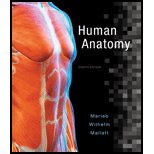
Where in the alimentary canal does propulsion occur?
To review:
The propulsion site in the alimentary canal.
Introduction:
Alimentary canal is a part of the digestive system of the human body. It is a passage starting from the mouth and ends at the anus. It is also known as the gastrointestinal tract. The mouth, pharynx, esophagus, stomach, small intestine, and large intestine which lead to the anus are organs of the alimentary canal.
Explanation of Solution
The process through which the movement of food along the alimentary canal occurs is known as propulsion. The propulsion occurs throughout the alimentary canal. It is initiated by a voluntary movement and gets continued by an involuntary movement. The involuntary movement initiating propulsion is the swallowing of food and the movement continuing propulsion is peristalsis.
Peristalsis is the process in which smooth muscles lining the walls of the organs of the alimentary canal contract and relax in an alternative manner. This enables the movement of food from one part of the alimentary canal to another. The mixing of food with digestive enzymes also takes place due to propulsion.
Want to see more full solutions like this?
Chapter 23 Solutions
Human Anatomy (8th Edition)
- What is behavioral adaptarrow_forward22. Which of the following mutant proteins is expected to have a dominant negative effect when over- expressed in normal cells? a. mutant PI3-kinase that lacks the SH2 domain but retains the kinase function b. mutant Grb2 protein that cannot bind to RTK c. mutant RTK that lacks the extracellular domain d. mutant PDK that has the PH domain but lost the kinase function e. all of the abovearrow_forwardWhat is the label ?arrow_forward
- Can you described the image? Can you explain the question as well their answer and how to get to an answer to an problem like this?arrow_forwardglg 112 mid unit assignment Identifying melting processesarrow_forwardGive only the mode of inheritance consistent with all three pedigrees and only two reasons that support this, nothing more, (it shouldn't take too long)arrow_forward
- Oarrow_forwardDescribe the principle of homeostasis.arrow_forwardExplain how the hormones of the glands listed below travel around the body to target organs and tissues : Pituitary gland Hypothalamus Thyroid Parathyroid Adrenal Pineal Pancreas(islets of langerhans) Gonads (testes and ovaries) Placentaarrow_forward
 Human Physiology: From Cells to Systems (MindTap ...BiologyISBN:9781285866932Author:Lauralee SherwoodPublisher:Cengage Learning
Human Physiology: From Cells to Systems (MindTap ...BiologyISBN:9781285866932Author:Lauralee SherwoodPublisher:Cengage Learning Concepts of BiologyBiologyISBN:9781938168116Author:Samantha Fowler, Rebecca Roush, James WisePublisher:OpenStax CollegeEssentials of Pharmacology for Health ProfessionsNursingISBN:9781305441620Author:WOODROWPublisher:Cengage
Concepts of BiologyBiologyISBN:9781938168116Author:Samantha Fowler, Rebecca Roush, James WisePublisher:OpenStax CollegeEssentials of Pharmacology for Health ProfessionsNursingISBN:9781305441620Author:WOODROWPublisher:Cengage Human Biology (MindTap Course List)BiologyISBN:9781305112100Author:Cecie Starr, Beverly McMillanPublisher:Cengage Learning
Human Biology (MindTap Course List)BiologyISBN:9781305112100Author:Cecie Starr, Beverly McMillanPublisher:Cengage Learning





